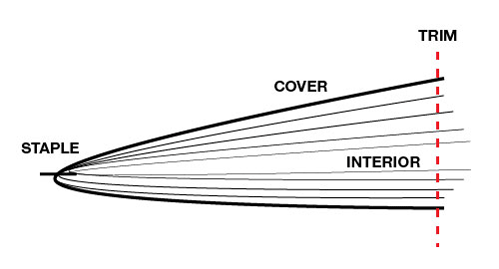Saddle stitching is one of the most versatile and widely used binding methods available and is a common application for booklets, brochures, pamphlets, newsletters and magazines. If your project is thicker than 1/4″, you’ll need to consider an alternative bindery method.
Apply the Formula
To determine whether your thick book project qualifies for saddle stitching: Take the page count, divide it by two, then multiply that number by the caliper (thickness) of the stock. For example, an 96-page book divided by two is 48. Next, if you’re using 80lb Satin or Dull Text coated paper stock, multiply by .0045 and then add in 0.011" for the cover stock of 100# Satin or Dull Cover, so the total thickness for this example is 0.227". As long as the final number remains under 0.25", your project is a saddle stitching candidate. Please see THICKNESS OF THE POPULAR PAPER STOCKS chart.
Account for “Shingling or Creep"
Shingling, or creep, is a result of paper’s third dimension: thickness. As a saddle stitched book gets thicker, the inner pages are actually progressively narrower than the outer ones. to calculate the actual creep size, we use this formula: Number of pages divided by 4 times thickness of stock (# of pages / 4 * thickness of stock). To compensate for this “shingling” effect, the copy on each page must be moved back from the face. This is done incrementally on each successive page, and if done properly, results in an even appearance of copy placement throughout the book. Please see THICKNESS OF THE POPULAR PAPER STOCKS chart.
Chipping is Normal
Once the book exits the stitching section of a saddle stitching production line and enters the trimmer, clamps are lowered, holding the book in place. Since the spine edge is slightly curved at the backbone, it isn’t fully supported throughout the cut. This means the trimming knives cut cleanly through the top and bottom pages, but at the backbone, where there isn’t any support, a slight tearing or “chip” occurs. This small “chip” tends to be more noticeable on thicker books than thin ones.



